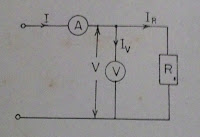Resistance is classified into three categories for the sake of Measurement. Different categories of Resistance are measured by different technique. That’s why they are classified. They are classified as
Low Resistance: Resistance having value 1Ω or below are kept under this category.
Medium Resistance: This category includes Resistance from 1Ω to 0.1 MΩ.
High Resistance: Resistance of the order of 0.1 MΩ and above is classified as High resistance.
In this section, we will discuss the method of measurement of Medium Resistance. The different methods used for Medium resistance are as follows:
· Ammeter Voltmeter method
· Substitution Method
· Wheatstone Bridge Method
· Ohmmeter Method
Ammeter Voltmeter Method:
There are two possible connections for the measurement of Medium Resistance using Ammeter Voltmeter Method as shown in figure below:
In both the cases, the reading of Voltmeter and Ammeter is taken. If the Voltmeter reading is V and Ammeter reading is I then the measured Resistance will be
Rm = V/I
This measured Resistance Rm will be the true value of the Resistance if and only if the Resistance of Ammeter is zero and that of Voltmeter is infinite. But actually this is not possible to achieve zero resistance Ammeter and infinite Resistance Voltmeter. Therefore measured value of resistance Rm will deviate from the true value R (Say).
So we will discuss both the circuit individually and will calculate the percentage error in the measurement.
Case1:
We consider first kind of connection as shown in figure 1 above. It is clear from the figure that Voltmeter is measuring the Voltage drop across the Ammeter as well as resistor. So V = Va + Vr
Let current measured by Ammeter = I
Therefore, measured Resistance Rm = V/I
So, Rm = (Va+Vr) / I =(IRa+IR) / I = Ra+R
Therefore, the measured Resistance is the sum of Resistance of Ammeter and true Resistance. Therefore measured value will only represent true value if Ammeter Resistance Ra is Zero.
True value of Resistance R = Rm –Ra
= Rm(1-Ra/Rm)
Relative Error = (Rm-R)/R = Ra/R
Therefore, Relative Error will be less if the true value of Resistance to be measured is high as compared to the internal Resistance of Ammeter. That’s why this method should be adopted when measuring high Resistance but it should be under Medium Resistance category.
Case2:
We will consider second connection in which Voltmeter is connected in which Voltmeter is connected toward Resistance R whose value is to be measured.
It is obvious from figure that Ammeter will read the current flowing through the Voltmeter and Resistance R. Therefore current measured by Ammeter Ia = Iv+Ir
So, Ia = Iv+Ir
= V/Rv+V/R where Rv is Resistance of Voltmeter and V is Voltmeter reading.
Measured Resistance Rm = V/Ia
= V/(V/Rv+V/R)
= RvR/(R+Rv)
= R/(1+R/Rv) ….Dividing Numerator and Denominator by Rv
Therefore, true value of Resistance R = RmRv/(Rv-Rm)
= Rm(1-Rm/Rv)
Therefore, true value of Resistance will only be equal to measured value if the value of Voltmeter Resistance Rv is infinite.
If we assume that the value of Voltmeter Resistance Rv is large as compared to the Resistance to be measured R, then Rv>>>Rm
So, True value R = Rm(1+Rm/Rv)
Thus from the above equation it is clear that the measured value of Resistance is smaller than the true value.
Relative Error = (Rm-R)/R
= -R/Rv
Therefore, it is clear from the expression of Relative Error that, error in measurement will be low if the value of Resistance under measurement is very less as compared to the internal Resistance of Voltmeter.
This is the reason; this method is used for the Contact Resistance Measurement. As the value of Contact Resistance is of the order of 20 micro Ohm which is very less as compared to the internal Resistance of Voltmeter.
The Voltmeter Ammeter Method for Cases1 and Case2 are simple method but it is not accurate method. The error in the value of Resistance depends on the accuracy of Ammeter as well as Voltmeter. If the accuracy of both the instrument are supposed 0.5% then when both the instrument read near full scale, the error in measurement of Resistance may vary from 0 to 1% while if both the instrument read near half scale then error may double and so on.
However this method is very useful where high accuracy is not required. The suitability of Case1 or Case2 depends on the value of Resistance to be measured. The division point between the two methods is at the Resistance for which both the method give same Relative Error.
So, Ra/R = R/Rv
For the Resistance greater than the value given above,Case1 is used while for the value of Resistance lower than R given above Case2 is used.
Check this Book for Electrical Measurement and Instrumentation. It is really awesome and concepts are dealt with very nicely.





Give some applicarion for the voltmeter and ammeter method….and give the difference between the ammeter voltmeter method and voltmeter ammater method…
Thanks, that was really useful.